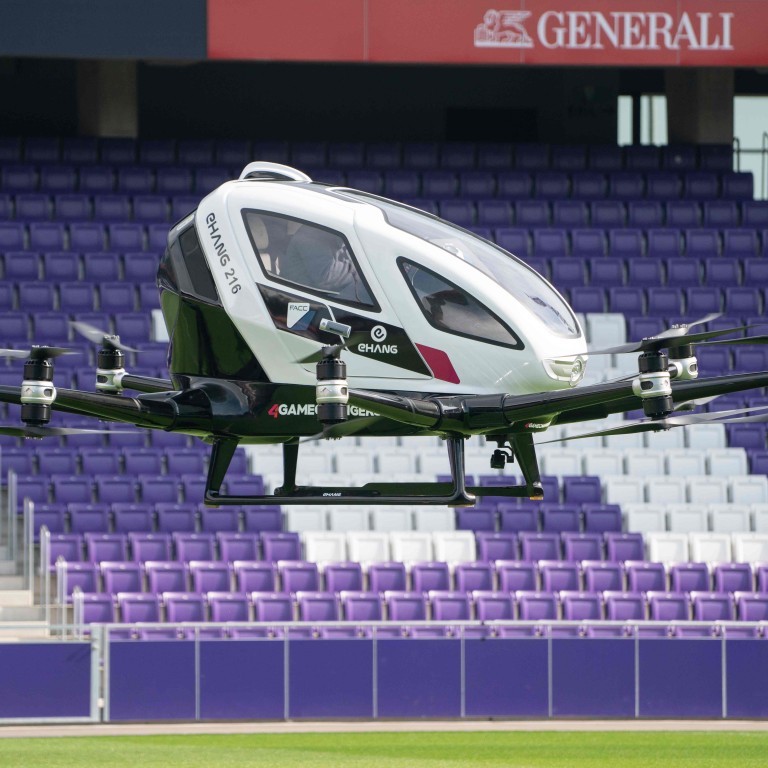
Is it a bird, is it a plane? No, it’s Ehang’s flying taxi
- The two-seater, electric-powered Ehang 216 autonomous flying vehicle can cover a distance of about 30 kms at speeds of up to 130km per hour
Commuters in China may soon be riding in autonomous flying taxis, soaring over busy streets and skyscrapers at the push of a button, thanks to Guangzhou-based Ehang, which describes itself as the world's first maker of passenger-grade, electric autonomous aerial vehicles.
Flying taxis have been talked about for years in China and now the buzz over Ehang’s passenger drones is rising after the start-up said “commercial flights are on the horizon”.
“We expect to operate a line of commercial flying cars in Guangzhou soon,” said Derrick Xiong Yifang, co-founder of Ehang in an interview last week.
Xiong, however, did not provide details on when commercial operations will start, how many Ehang flying cars will initially be made available and the costs involved in this major new enterprise. The company announced earlier last month that its headquarters in Guangzhou will serve as the first “urban air mobility pilot city” for its flying cars in the country.
China is pushing the adoption of new transport technologies, such as autonomous driving, to help deal with congested roads in its major cities. If Ehang successfully launches its commercial transport business, China will become the first country in the world to have a fleet of electric autonomous flying taxis serving daily commuters.
Ehang still faces a number of issues, from new regulations and public safety concerns to establishing rigid personnel training and equipment maintenance, before its commercial flying taxi operation takes off.
“Urban air mobility is a potentially huge market, but regulation remains a big obstacle,” said Chinese aviation expert Zhang Baoxin. “There is a long way to go from test flights to daily transport operations … The development of autonomous cars has set the example on the challenges that lie ahead.”
Ehang’s Xiong said the company believes it can overcome “fundamental challenges to launching its commercial flying taxi operations, whether in terms of technology or regulation”.
“We are working with Chinese regulators to help set up rules,” he said.
Nerves, waiver, screaming, lift-off, joy: a two-minute test ride in a passenger drone from China’s Ehang
In February last year, Ehang became the first company in China to initiate tests of its electric-powered, autonomous flying drone with passengers on board. More than 200 people, including the deputy mayor of the southern coastal city of Guangzhou, were among the passengers who flew on round trips of up to 15 kilometres, with some flights reaching the vehicle’s top speed of 130km per hour.
Ehang was established in 2014 by Chinese engineer Hu Huazhi with backing from GGV Capital. Ehang unveiled its first flying taxi model, the 184, at the CES trade show in last Vegas in 2016. Its latest model, the two-seater Ehang 216, was unveiled in April this year in Vienna, Austria.
Passengers on the Ehang flying taxi, which has 16 separate electric motors connected to 16 propeller blades, must first input their flight path into the control system, tap a button and the drone will automatically take off from there. The Ehang 216 model can cover a distance of about 30 kms at speeds of up to 130km per hour, according to the company. It said the vehicle is stable enough to fly even when there is a thunderstorm or typhoon-level conditions. In the event something goes awry, a human pilot in the company’s control centre will remotely take over from the autonomous system.
“China has potentially stronger demand for flying cars, compared with countries like the US, because of the chronic traffic congestion in many cities here,” aviation expert Zhang said. Apart from regulation, Zhang expressed concerns over the stability of the vehicle’s lithium battery up in the air as well as the development of strategically located charging stations for the service.
Flying taxis? Uber has a competitor in Chinese drone maker Ehang
In the US, the Federal Aviation Administration has been slow to adopt rules for new aviation technologies as alternative transport systems for daily commuters, despite efforts in the field by the likes of Airbus and ride-sharing giant Uber Technologies.
To be sure, even Tesla co-founder and chief executive Elon Musk said flying cars could potentially be dangerous. “Obviously, I like flying things,” Musk said in an interview with Bloomberg two year ago. “But it’s difficult to imagine the flying car becoming a scalable solution. Your anxiety level will not decrease as a result of things that weigh a lot buzzing around your head.”
With the road traffic bottlenecks experienced in China, Ehang is betting that the efficiency of its autonomous electric flying taxis will prove attractive to commuters.
“More than 90 per cent of daily city travel in China is shorter than 20km, which means the majority of the routes [for Ehang’s flying taxis] will take less than 20 minutes to complete,” said Xiong, adding that battery power will not be an issue.
“If I have to identify a challenge for our commercial operations, it will be how to educate people into accepting this new product.”

